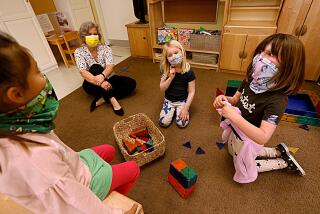Poverty Study Puts New Wrinkle in Welfare-to-Work Debate
- Share via
WASHINGTON — The poverty rate for families headed by single, working women held steady in the late 1990s, despite a booming economy that lifted other households, according to a study that previews the next debate on welfare policy and the government’s role in helping the poor.
From 1995 to 1999, the families of single, working mothers--a group that includes many who left the welfare rolls during that time--achieved income gains in the labor force that were largely wiped out by the loss of government aid, such as welfare checks and food stamps.
As a result, the 19.4% poverty rate for such families in 1999 was essentially the same as four years earlier, even though private earnings increased in those households, according to a report by the Center on Budget and Policy Priorities, a liberal research organization in Washington.
By comparison, the poverty rate for all families with children was 10.6% in 1999, compared with 13% four years earlier, reflecting clear gains from the late 1990s boom.
“If you really want people to work, you want to reward them,” said Wendell Primus, a former Clinton administration welfare official and expert on income security issues at the think tank. “People who work should be a whole lot better off than people who don’t. What this study is saying is they aren’t.”
The findings, which come as the historic welfare reform law approaches its fifth birthday, could provide grist for future debate because Congress next year must fund the welfare grant and reconsider its priorities for aiding the poor. Critics of the existing welfare policy contend that former beneficiaries, cut off by the new time limits for receiving benefits, need more support services to help them not only survive in the workplace but also climb the economic ladder.
Others, however, maintain that a reduction in poverty was never the first aim of welfare reform, that the goal was to cut the welfare rolls, which has been achieved to a remarkable degree.
“I don’t know any proponent of welfare reform who thought the immediate goal was to reduce poverty,” said Douglas J. Besharov, a social welfare scholar at the conservative American Enterprise Institute. “For many of these women, it’s the first or second serious job that they’ve ever had. It’s going to take time for them to move up.”
The 1996 welfare law looms as an important benchmark in the time frame studied by researchers. From 1993 to 1995, when safety net programs were generally expanding, the poverty rate declined for families headed by working mothers, slipping to 19.2% from 24.5%, according to the think tank’s analysis. By contrast, the poverty rate held steady from 1995 to 1999, according to the study, which considered private earnings, government benefits and taxes.
A separate gauge, which seeks to measure the severity of poverty in a population group, also suggested that working families led by single mothers lost ground in the late 1990s. Known as the “poverty gap,” it is an estimate of the cost of pulling the entire group above the poverty line, and it increased in the late 1990s.
“The general message of this report is that for very disadvantaged single mothers, work alone does not seem to be enough,” said Kathryn H. Porter, who is co-author of the report with Allen Dupree, also of the Center on Budget and Policy Priorities.
Since 1996, welfare rolls nationally were cut by more than half from their 1994 peak of 14.3 million. States faced with the sudden windfalls of unspent welfare funds steered some of the money into support services for the working poor, such as child care, transportation and training.
Even as states did so, welfare beneficiaries often experienced a sharp loss of benefits overall. Not only were their monthly checks eliminated or scaled back, but many who remained eligible for food stamps were also cut off when their welfare status changed.
“These two factors [welfare and food stamps] are offsetting the earnings gains,” said Primus of the Center on Budget and Policy Priorities. “They’re not coming out ahead. That’s really the bottom line of this story.”
But others argue that the move from welfare to work a good thing. “Mothers went to work and the sky didn’t fall,” said Besharov. “We halved the welfare rolls without any apparent harm to welfare recipients. That’s the story here.”
More to Read
Get the L.A. Times Politics newsletter
Deeply reported insights into legislation, politics and policy from Sacramento, Washington and beyond. In your inbox twice per week.
You may occasionally receive promotional content from the Los Angeles Times.










